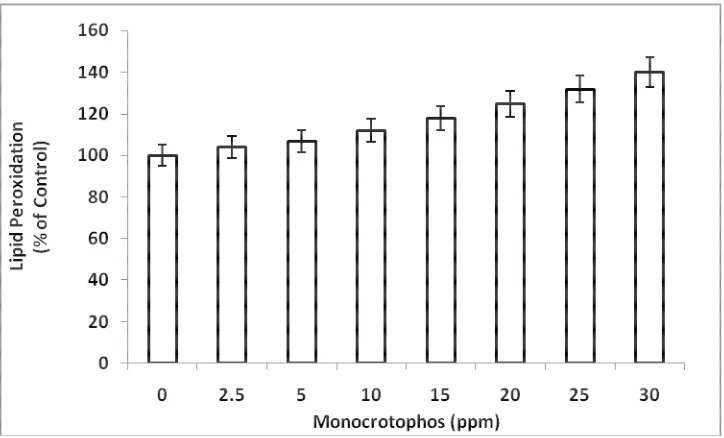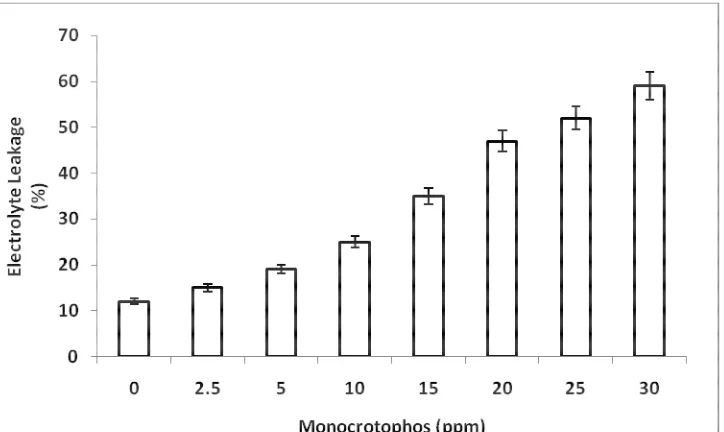Journal of Chemical and Pharmaceutical Research
__________________________________________________
ISSN No: 0975-7384 CODEN(USA): JCPRC5
J. Chem. Pharm. Res., 2011, 3(3):381-388
Growth, photosynthetic pigments and antioxidant responses of
Azolla filiculoides to monocrotophos toxicity
Abhishek Chris*1, Luxmisha G2, Jamson Masih3 and G Abraham4
1
Department of Botany, Wilson College, Mumbai, India
2
Department of Biological Sciences, SHIATS , Allahabad, India
3
Department of Chemistry, Wilson College, Mumbai, India
4
CCUBGA, Indian Agricultural Research Institute, New Delhi, India
______________________________________________________________________________
ABSTRACT
The paper deals with the pesticide monocrotophos (0 – 30 ppm) induced changes in physiological and biochemical parameters related to growth and defense system in Azolla filiculoides . Monocrotophos treatment on fresh weight, dry weight, doubling time, chlorophyll, carotenoids, relative growth rate, lipid peroxidation, electrolyte leakage, proline accumulation and activities of superoxide dismutase and peroxidase were analyzed. Growth and photosynthetic pigments, i.e. chlorophyll and carotenoids were adversely affected by monocrotophos treatment and the inhibition was found to be dose dependent. Pesticide treatment with increasing doses accelerated the formation of reactive oxygen species, i.e. O-2 and H2O2 in
cells progressively, whereby an enhanced lipid peroxidation and electrolyte leakage was noticed in A. filiculoides. Proline accumulation also showed a similar trend. As a consequence of reactive oxygen species (ROS) generation in monocrotophos treated plants, the activity of superoxide dismutase (SOD) and peroxidase (POD) were enhanced considerably.
Keywords: Azolla filiculoides, monocrotophos, growth, MDA, SOD, POD.
______________________________________________________________________________
INTRODUTION
ecosystems for a long period of time [2].Water bodies such as ponds, water reservoirs, aquaculture shallow water and paddy fields are highly eutrophic and maintain large standing crops of phytoplankton’s and, floating plants and some aquatic fern like Azolla. [3]. An
Azolla-Anabaena association is a favorite biofertilizer of crops, especially in rice paddy fields because
of its ability to fix dinitrogen at high rates and low cost. In addition, Azolla is a suitable candidate as an animal feed, human food water purifier, medicine, hydrogen fuel, biogas producer, weed controller, suppresser of weeds and reduces ammonia volatilization after chemical nitrogen application and rightly called as “green gold” [4].Though the considerable amount of work on abiotic stress induced inhibitory effect of growth, photosynthetic pigments content and nitrogen metabolism have been done in recent years [5,6,7] but insecticides particularly monocrotophos induced effect on growth ROS generation, antioxidants and lipid peroxidation in Azolla particularly A.filiculoides are yet to be investigated. Considering the importance of Azolla in rice fields, and frequent use of pesticides against pests, the authors set forth the objective of investigating the impact of insecticide monocrotophos on growth, photosynthetic pigments and antioxidant systems, lipid peroxidation and membrane leakage in Azolla filiculoides.
EXPERIMENTAL SECTION
Plant material
Azolla filiculoides were collected locally from paddy fields.Plants were washed and cleaned of contamination organisms. The plants were surface sterilized with a solution of mercuric chloride (0.1% for 30 min) and were dipped immediately into a large volume of sterile distilled water. Plants were then transferred into dishes containing combined-N free 2/5 stength sterile Hoagland’s medium[8] and 0.04mM ferrous ion as Fe-EDTA, pH 5.6.The cultures were grown at 26 oC under a 16:8 (light: dark) photoperiod with light from a combination of incandescent and cool white light fluorescent lamps at a photon fluence rate of 95 µmol m-2s-1. Fronds were routinely transferred into fresh medium twice a week to maintain plants in a sterile state. Log phase plants were used for experiments.
Growth estimation
Azolla filiculoides plants were rinsed in an aerated iso osmotic solution of sorbitol were blotted
dry on filter paper and weighed to represent their fresh weight (FW).Dry weight (DW) was determined by drying the samples in a hot air oven at 90 0C for 24 h to a constant weight.
Chlorophyll and carotenoids estimation
Chloropylls and carotenoids were extracted from fronds with 80% acetone.Chlorophyll and carotenoids were estimated spectrophotometrically according to the method of Litchenthaler and Welburn [9].
Assay of enzymes
2-thiobarbituric acid and heated at 95 oC for 25 min [12].Melondialdehyde (MDA) content was determined spectrophotometrically at A532 and corrected for non specific turbidity at A600.
Proline estimation
Proline concentration in treated and untreated fronds was determined spectrophotometrically by the method of Bates, et al. [13].
Statistical analysis
All the data obtained of Azolla filiculoides in terms of growth, chlorophyll, carotenoids SOD, POD, lipid peroxidation, electrolyte leakage and proline accumulation in response to different levels of monocrotophos were statistically analyzed for their significance. An analysis of variance (ANOVA) was performed using SPSS 10 program. The significance was tested at 0.05 (5%) level. Values presented in the text indicate mean values± of five replicates.
RESULTS AND DISCUSSION
The present study shows the effect of different concentrations of monocrotophos on the growth,pigments and antioxidants of A. filiculoides . All the concentrations of the pesticide reduced the growth of plants as evident from the growth parameters shown in Table 1. Fresh weight and dry weight of pesticide stressed plants were reduced by 17% , 30% ,49% ,50% and 23% ,34% ,47% and 48% respectively at 5,10,15 and 20 ppm concentrations. Plants were highly damaged at the concentration of 30 ppm. Our results are comparable to the observations made by Aida et al. [3] and recently done by El-Shahate et al.[14]. It is found that pesticide has an inhibitory effect on photosynthetic CO2 assimilation and protein synthesis Battah et al.[15]
Table 1: Effect of monocrotophos on fresh weight, dry weight, doubling time, total chlorophyll, carotenoids and relative growth rate.
Monocrotophos Fresh Weight
Dry Weight
Doubling Time
Total Chlorophyll
Carotenoids RGR
(ppm) (gm) (gm) (days) (mg g-1 F W) (mg g-1F W) µg-1 g-1day
-1
0 1.5±0.3 0.336±0.1 2.60±1.2 0.544±0.3 0.201±0.1 0.186±0.3.
2.5 1.6±0.5 0.384±0.1 2.77±0.5 0.423±0.1 0.179±0.0 0.190±0.2
(+1.2) (+14.28) (+6.53) (-22.25) (-10.12) (+2)
05 1.3±0.3 0.257±0.1 3.13±1.0 0.394±0.1 0.168±0.1 0.182±0.0
(-17.7) (-23.52) (+20.43) (-27.58 (-16.25) (-3)
10 1.1±0.4 0.220±0.1 3.79±1.1 0.377±0.2 0.161±0.0 0.175±0.0
(-30.08) (-34.53) (+45.94) (-30.70) (-19.80) (-6)
15 0.80±0.3 0.176±0.0 6.37±1.5 0.345±0.1 0.151±0.0 0.164±0.0
(-49.37) (-47.62) (+144) (-36.59) (-24.85) (-12)
20 0.78±0.4 0.174±0.0 6.73±1.6 0.329±0.1 0.140±0.0 0.159±0.0
(-50.64) (-48.22) (+158) (-39.53) (-30.12) (-15)
25 0.60±0.3 0.144±0.0 16.43±4.1 0.298±0.2 0.128±0.0 0.154±0.0
(-62.03) (-57.15) (+530) (-45.23) (-36.18) (-18)
30 0.49±0.1 0.107±0.0 30.11±9.5 0.258±0.1 0.113±0.0 0.150±0.0
(-68.99) (-68.16) (+700) (-47.54) (-43.61) (-20)
[image:4.595.126.488.495.714.2]Fig 2: Effect of different concentrations of monocrotophos on electrolyte leakage in Azolla filiculoides. All the values are significant at P<0.05
Fig 3: Effect of different concentrations of monocrotophos on proline in Azolla Filiculoides. Proline in untreated control was 6 [µg g-1 FW]. Mean± SE. All the values are significant at P<0.05
Fig 4: Effect of different concentrations of monocrotophos on superoxide dismutase (SOD) in Azolla filiculoides. SOD in untreated control was 5.2±0.9 [Unit (g FW) -1]. Mean± SE. All the values are significant at
[image:6.595.124.489.355.573.2]Fig 5: Effect of different concentrations of monocrotophos on peroxidase (POD) in Azolla filiculoides. POD in untreated control was 39.12±2.7 [n mol (g F W) -1 min-1]. Mean± SE. All the values are significant at P<0.05
Following monocrotophos treatment the proline level (Fig.3) in Azolla increased by 19% ,35% , and 49% at 2.5, 5 and 10 ppm and the highest level was found at 30 ppm i.e. 97%. Multiple defense systems that include both enzymatic and non enzymatic compounds have been reported in Azolla filiuloides against UV-B damage Masood et al.[5]. Enhancement in proline level may conferred the capacity to detoxify reactive oxygen species efficiently. This agrees well with the earlier observations that proline plays a significant role in detoxification of ROS [26]. However, an earlier observation by Chris et al.[27] showed that NaCl pre-treatment resulted in reduced lipid peroxidation, electrolyte leakage and cellular H2O2 levels in in Cylindrospermum sp.
exposed to UV-B due to cellular proline production induced by NaCl pre-treatment.
The total SOD activity of A. filiculoides exposed to monocrotophos increased steadily. SOD activity of Azolla plants increased by 5%, and 8%, at 5 and 10 ppm and it was highest at 30 ppm concentration (Fig.4) .A similar trend was also observed in the POD activity [Fig.5] .Recent evidence has shown that ROS, especially H2O2 and O-2, are involved in cellular signaling
processes as secondary messengers to induce a number of genes and enzymes such as POD and SOD [28], which invoke reactive oxygen species in stressed organisms. Thus the increased level of O-2 and H2O2 triggered the activity of several antioxidant enzymes such as superoxide
dismutase, peroxidase in Azolla filiculoides at all the concentrations of monocrotophos tested. Prasad et al. [23] observed enhanced activity of SOD and POD in Plectonema boryanum exposed to insecticide endosulfan. Changes in the level of antioxidants molecules are signals of plant tolerance/adaptation to stress condition.
CONCLUSION
The results demonstrated response in terms of growth, chlorophyll, carotenoids, proline accumulation, electrolyte leakage, lipid peroxidation, SOD and POD activities of Azolla
filiculoides in response to monocrotophos. The strong inhibitory effect on the growth and
the application of pesticide in crop fields is increasing and potential use of Azolla as a biofertilizer in such environment needs to be investigated in detail especially at molecular level .
Acknowledgements
Authors are thankful to Prof. M. S. Mishra Head, Department of Biological Sciences, Allahabad Agricultural Institute-Deemed University, Allahabad, India for providing lab facility. We are also grateful to Prof (Dr). R. B. Lal Hon’ble, Vice Chancellor AAIDU for encouragement.
REFERENCES
[1]. M Meghraj; K Venkateswarlu; A S Rao. Environ. Pollu.( Series A).,1986,15-22. [2]. P K Singh. Arch.Microbiol.,1973,89,317-320
[3].M Aida; H Ikeda; K Itoh; K Usui. Ecotox.Environ.Safe., 2006, 63,463-468. [4].G M Wagner. Bot.Rev. 1973.,1-26.
[5].A Masood; M Zeeshan; G Abraham. Acta.Biol.Hung., 2008, 247-257. [6].V Rai; A Rai. Plant.Soil.,1999,79-84.
[7].M Khorsavi; M Taghiganji; R Rakhshaee.Int.J.Environ.Sci.Tech., 2005, 2(1), 35-40 [8].M M Allen.J.Phycol.,1968.4,1-4
[9].H K Lichtenthaler; A R Welburn. Bochem.Soc.Transac., 1983,591-592. [10].H E Gahagen; R E Holm; F B Abeles. Physiol. Plant.1968, 21, 1270. [11].C N Giannopolitis; S K Ries. Plant.Physiol.1977, 59,309-314. [12].R L Heath; L Packer. Arch.Biochem.Biophy., 1968,125,189-198 [13].L S Bates; R P Waldren; I D Teare.Plant.Soil., 1973, 205-207
[14].R M EL-Shahate; M M I El-Araby; E W Eweda; M N El-Berashi. J.American.Sci. 2011, 7(1), 1020-1031.
[15].M G Battah; E F Shaban; I A Kobbia; H M Elodel.Ectox.environ.Safe.2001.49, 235-239. [16].B D Kaushik; G S Venkataraman.Curr.Sci.1983.52,321-323.
[17].M Madhhaiyan; S Poonguzhali; K Hari V S Sarvanan; S Tongmin. Pest. Biochem. Physiol.
2006, 84,143-154.
[18]. S Kannaiyan . The Phil. Agric.1988. 71(2): 257-261.
[19]. S M Prasad; M Zeeshan.2004. Environ Exp. Bot 2004, 52, 175-184.
[20].V Mishra; G Srivastava; S M Prasad; G Abraham.2008, Pest. Biochem. Physiol.92, 30-37 [21]. S. Palanisami; D Prabaharan; L. Uma. Pest. Biochem. Physiol.2009.94, 68-72.
[22]. S Kaushik; Inderjit. Environ.Exp.Bot.,2006, 55, 41-48.
[23].S M Prasad; D Kumar; M Zeeshan. J. Gen. Appl. Microbiol. 2005, 115-123
[24].A Chris; M Zeeshan; G Abraham; S M Prasad. Environ Exp.Bot 2006, 57, 154-159.
[25].S Viveros;G D Gonzalez-Mendosa;A Alacon;R Ferrera- Cerreto. Int.J.Agri.Biol.12,365-368.



